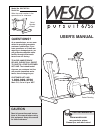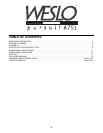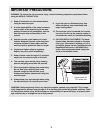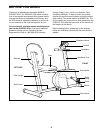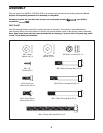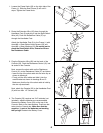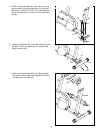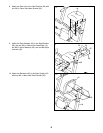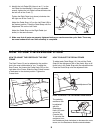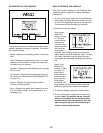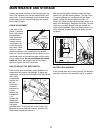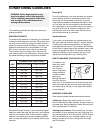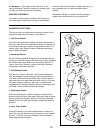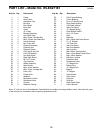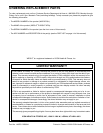
12
The following guidelines will help you to plan your
exercise program.
EXERCISE INTENSITY
To maximize the benefits of exercising, it is important
to exercise with the proper intensity. The proper inten-
sity level can be found by using your heart rate as a
guide. For effective aerobic exercise, your heart rate
should be maintained at a level between 70% and
85% of your maximum heart rate as you exercise.
This is known as your training zone. You can find
your training zone in the table below. Training zones
are listed according to age and physical condition.
During the first few months of your exercise program,
keep your heart rate near the low end of your training
zone as you exercise. After a few months of regular
exercise, your heart rate can be increased gradually
until it is near the middle of your training zone as you
exercise.
Burning Fat
To burn fat effectively, you must exercise at a relative-
ly low intensity level for a sustained period of time.
During the first few minutes of exercise, your body
uses easily accessible carbohydrate calories for ener-
gy. Only after the first few minutes of exercise does
your body begin to use stored fat calories for energy. If
your goal is to burn fat, adjust the intensity of your
exercise until your heart rate is near the low end of
your training zone as you exercise.
Aerobic Exercise
If your goal is to strengthen your cardiovascular sys-
tem, your exercise must be Òaerobic.Ó Aerobic exercise
is activity that requires large amounts of oxygen for
prolonged periods of time. This increases the demand
on the heart to pump blood to the muscles, and on the
lungs to oxygenate the blood. For aerobic exercise,
adjust the intensity of your exercise until your heart
rate is near the high end of your training zone.
HOW TO MEASURE YOUR HEART RATE
To measure your
heart rate, place
two fingers on
your wrist as
shown. Stop exer-
cising and take a
six-second heart-
beat count.
Multiply the result
by ten to find your
heart rate. (A six-second count is used because your
heart rate drops quickly when you stop exercising.) If
your heart rate is too high or low, adjust the intensity
of your exercise.
WORKOUT GUIDELINES
Each workout should include three important parts:
A Warm-upÑBegin each workout with 5 to 10 min-
utes of stretching and light exercise. A proper warm-up
increases your body temperature, heart rate and circu-
lation in preparation for exercise.
Training zone exerciseÑAfter warming up, increase
the intensity of your exercise until your heart rate is in
your training zone for 20 to 30 minutes. NOTE: During
the first few weeks of your exercise program, do not
keep your heart rate in your training zone for longer
than 20 minutes.
CONDITIONING GUIDELINES
TRAINING ZONE (BEATS/MIN.)
20
25
30
35
40
45
50
55
60
65
70
75
80
85
AGE CONDITIONEDUNCONDITIONED
133Ð162
132Ð160
130Ð158
129Ð156
127Ð155
125Ð153
124Ð150
122Ð149
121Ð147
119Ð145
118Ð144
117Ð142
115Ð140
114Ð139
138Ð167
136Ð166
135Ð164
134Ð162
132Ð161
131Ð159
129Ð156
127Ð155
126Ð153
125Ð151
123Ð150
122Ð147
120Ð146
118Ð144
WARNING: Before beginning this or any
exercise program, consult your physician.
This is especially important for individuals
over the age of 35 or individuals withpre-
existing health problems.



